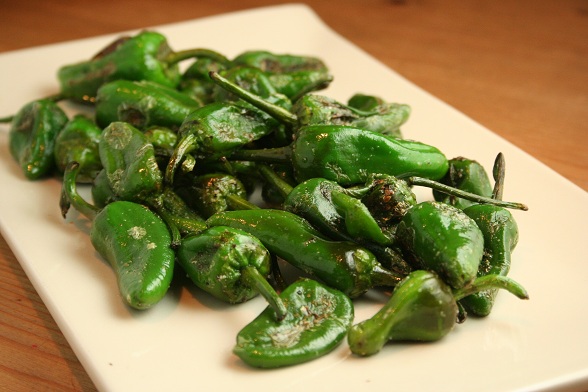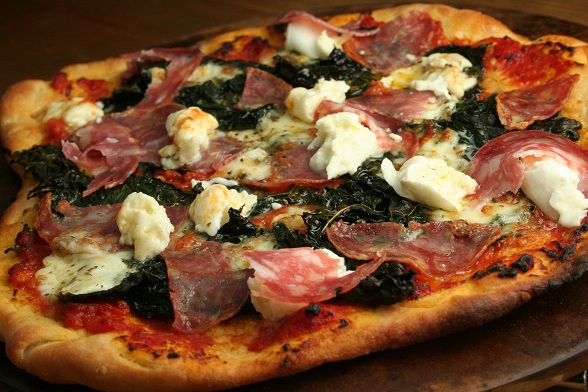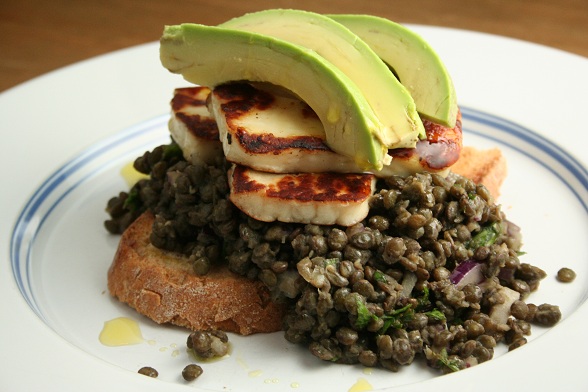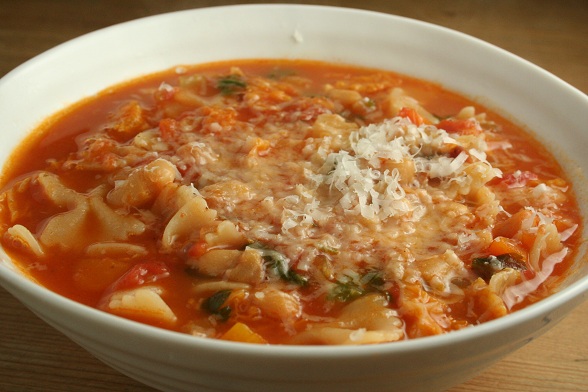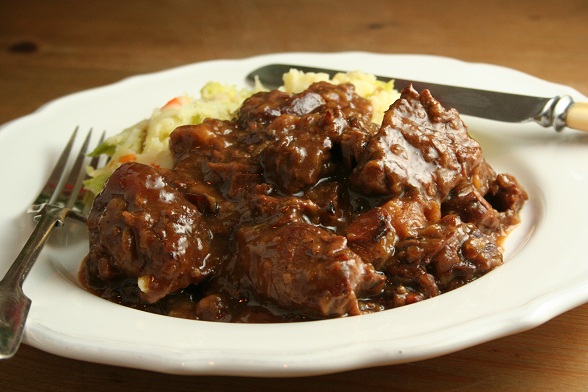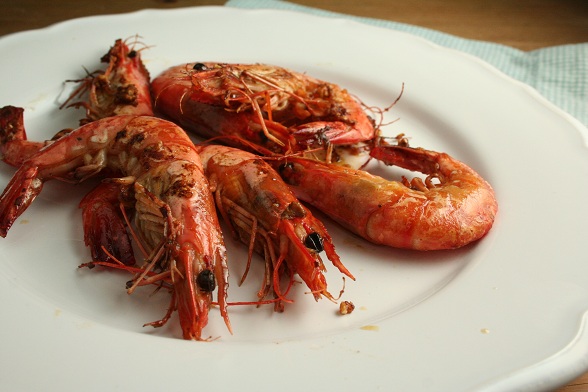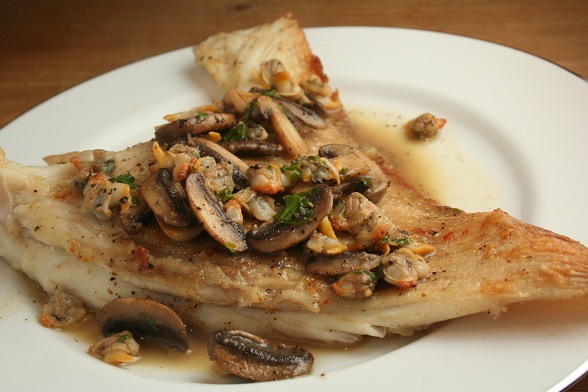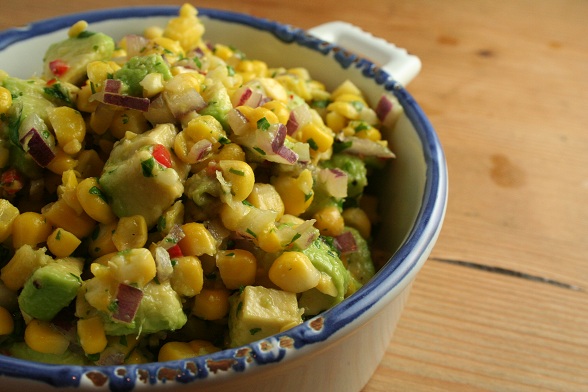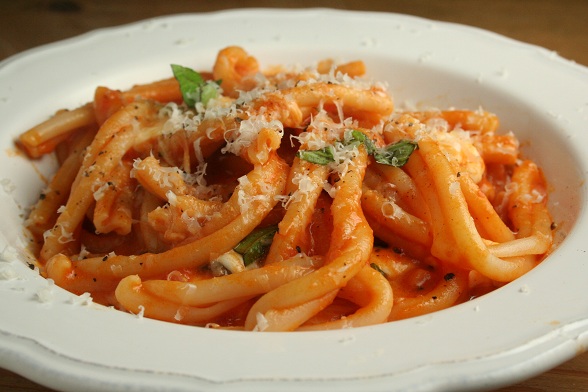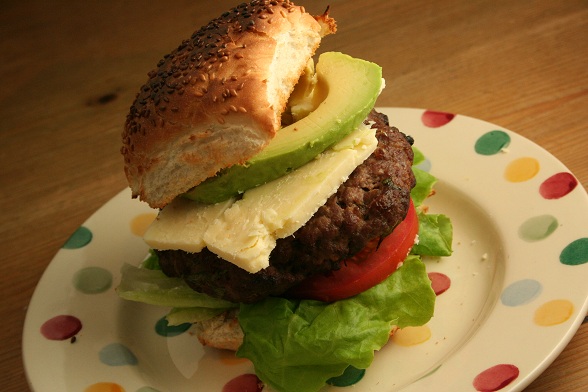Home Made Tapas
Saturday night! As we weren’t going out, that meant that it was time to cook something “interesting”. Where the exact meaning of “interesting” does of course vary depending on what mood we are in, but generally cooking on a Saturday means that there is more time available to prepare, so the range of what can be achieved without consequently eating at midnight is therefore greater.
As it turned out, most of what we ended up cooking this time round was relatively quick to prepare, but there was a range of it so that meant that it was still “interesting”: a range of small tapas-like dishes, mostly from the Moro cookbook. It did turn out to be something of a game of two halves though; more on that later. So, armed with a glass of Manzanilla, we set about preparing. First up was Chorizo in sherry. Very simple: Fry some chorizo and then splash some Fino (we used Manzanilla as that is what we had) over it. Tasty and chorizoey as it should be, with a light tang from the sherry but that mostly gets lost in the paprika-flavoured chorizo oil.
Next was clams in Manzanilla (we stuck to the recipe properly here, which was the reason we had Manzanilla at hand). Again, very quick but not quite as dead simple as the chorizo: Fry some thinly sliced garlic in olive oil. When it starts to brown, add the clams, manzanilla and some chopped parsley. After a few minutes, when the clams have opened, add some more chopped parsley and some black pepper and serve with a lemon wedge to squeeze over the clams if the fancy takes you. We ate them with some bread made from left-over pizza dough from last night, which was great to soak up the clam-and-Manzanilla-and-parsley sauce. The clams themselves were very good too; this was our favourite dish of the evening, which was good because at the last minute we had realised that we didn’t have any clams and had made a special trip to buy some.
We had had a bag of Padron peppers in the fridge for a while and this seemed like a perfect opportunity to use them up. Tossed in oil and salt, then fried until starting to blister, they came out looking good. But didn’t taste good as they were too old and some were going brown inside; clearly been in the fridge for too long. So we didn’t eat them, which was a shame as we had been planning to serve pork skewers on top of them. Remember I said this was a meal of two halves? This was the beginning of the not-so-good half.
Griddled chicory served with jamon and a sherry vinegar and thyme dressing sounded like a good combination and it mostly worked well: the bitter crunch of the chicory complemented the soft, salty jamon and the sweet and sour dressing. Kerri wasn’t a fan of the dressing though, finding it too sweet and cloying.
Finally onto the Moorish skewers, which were initially due to be served on top of the Padron peppers in the way that we had had lamb chops served on Padron peppers in a tapas restaurant. Seeing the recipe in the book, they looked familiar but we couldn’t remember if we had actualy cooked them before or not. Turned out that we had, and the reason that we couldn’t remember very well was that it was three years ago! This was the only part of the meal that required advance preparation – grinding up spices and marinating the meat in them for two hours before cooking – recipe for this at the end of the post.
Our original intention had been to barbecue these because the weather forecast had looked really good, but when the actual weather arrived it clearly hadn’t read the forecast because it wasn’t as good as we had hoped for. So we did these under the grill in our oven. The grill in our oven is really rubbish, It heats up and then turns itself off for a while and then heats up again. When I grill something I want constant, blasting heat, as if it was on a barbecue. Not some sort of thermostat-controlled namby pamby grill that means that by the time you have any sort of char on the outside of your meat you have completely overcooked it and dried it out. In fact we had to put the skewers in a frying pan eventually to try to get some char on them.
The spicy marinade gave the pork a lovely flavour, but they were dried out as you probably gathered from my rant. We made a comment on that previous post about using less saffron next time. We hadn’t read it, but ended up using less saffron purely because we didn’t have much left. Which worked out well.
Ingredients:
1 pork fillet of 500g, trimmed of fat and sinew
sea salt and black pepper
1/2 heaped teaspoon each of coriander seeds, cumin seeds and fennel seeds, all roughly ground
1 teaspoon sweet smoked Spanish paprika
2 garlic cloves, crushed to a paste with salt
a good pinch saffron (about 60 strands) infuxed in 2 tablespoons of boiling water (we used less than half of this this time round)
1/2 small bunch fresh oregano roughly chopped or 1 teaspoon dried oregano
1 bay leaf, prefereably fresh, crumbled or chopped very finely
1 dessertspoon red wine vinegar
1 dessertspoon olive oil
Cut the pork fillet in half lengthways and then into 3cm cubes. Flatten these cubes slightly. (We didn’t cut it in half and just sliced it into thinnish round slices, didn’t need to flatten them) Place the pork in a large mixing bowl and add the marinade dry spices, garlic, saffron-infused water, oregano, bay and vinegar and mix thoroughly. Then add the olive oil, toss again and leave in the fridge for 2 hours so the flavours or the marinade get into the meat.
Thread onto skewers (remember to soak them beforehand if you are using wooden ones) and cook over high heat, on a barbecue or griddle pan or under a decent grill (not like ours). Enjoy!



Cavolo Nero Pizza
I’ve been thinking about this for a while but wasn’t entirely sure it was going to work. I considered swapping the cavolo nero for spinach and making a more traditional fiorentina pizza but was intrigued enough by the idea to continue and risk ruining our favourite Friday night dinner.
We both love the rich, irony flavour of the cavolo nero but knew it would take some balancing to work as a pizza topping. Our usual tomato sauce is light and fresh but this time, we made a deeper, more heavily reduced sauce with plenty of garlic and oregano to stand up to the greens.
Stephen cleverly suggested tossing the previously-steamed cavolo nero in some grated lemon zest to add an acidic note and, as well as the cooked mozarella and salami, we kept some aside and added it to the pizza when it came out of the oven. The fresh salami added some sweetness and the “raw” mozarella provided a lightness.
We both said it was the best pizza we’ve ever had. The flavour combinations all worked together brilliantly and, without being too immodest, were as perfectly balanced as we could have hoped for. I’m looking forward to trying a similar combination next week with pasta but I might just cook this again. And again.



Halloumi with Lentils and Avocado
We always keep halloumi in the fridge since it has a long shelf life and it’s so useful if you find yourself in a cheese-based emergency. It wasn’t exactly an emergency this evening but we had planned to go out and changed our minds at the last minute. There wasn’t much else around the kitchen would could be turned into a meal so out came the halloumi. I had planned to chop the avocado into the lentils but forgot so hastily threw it on the top just before Stephen took the picture. We ended up mashing it onto the toast and then piling the lentils and halloumi on top and it was brilliant. In fact, I think it’s one of the best things I’ve eaten for a while and considering it was made up of store-cupboard ingredients and took very little time to put together pleases me even more.
No need for a recipe, just cook the puy lentils and then dress with some salt and pepper, red onion, olive oil, lemon juice and herbs. Fry the halloumi and serve on avocado toast.



Minestrone Soup
We had half a cabbage left over from the weekend and I didn’t know what to do with it. I did a quick search through the archives and came across this minestrone soup recipe we cooked earlier in the summer which included the comment: “Most of the recipes I found used cabbage which I’m sure is lovely in winter but it made more sense to use some summer vegetables this time”. While it’s not quite winter yet, it was an ideal way to use up the cabbage so I started cooking it last night. The beans took forever to cook though so we had to finish it this evening but that worked out well since it gave the flavours time to develop overnight.
This version was much more liquid than last time and probably had too much pasta in it but it suited us both, I got to eat more pasta while Stephen ate more soup. The leftovers, minus the liquid, and with some added cheese made a good lunch the next day too.



Chicken Tagine
Time permitting, I like to have something cooked and in either the fridge or the freezer ready to reheat when we get home from work on a Monday night. It takes me a little while to get used to the fact that the day isn’t my own and, by the time I get home, I’m tired, hungry and severely lacking in creativity when it comes to all things kitchen-related. The best solution is to cook something on a Sunday that will generate leftovers but that isn’t always possible, which is how we came to find ourselves cooking chicken tagine at 8pm last night.
We’d been out for the day and planned to cook the chicken this evening, ready for tomorrow night. All we really wanted to do was enjoy the last of the weekend but we both knew that a small amount of effort would reward us in a big way when Monday evening came round and we didn’t need to cook anything. And it really is only a small amount of effort since this is so quick and easy to cook, especially with the modifications we made this time around.
Last time we cooked tagine, we followed all the rules of marinating the chicken in advance. We didn’t have time for that last night but neither of us thought it made a huge amount of difference to the finished dish. We didn’t have any fennel so substituted celery and fennel seeds which worked well, the aniseedy flavour was a little more dilute than last time but this gave the other flavours a chance to shine which I really appreciated since fresh fennel isn’t one of my favourite flavours. More olives and preserved lemons than last time too which upped the zing factor.
While it would have been nice to lounge around last night, watching bad TV or browsing the web, I’m really glad we made the effort to cook this. After the drama of the tube-strike today and the long journey home, it was bliss to heat something up quickly and sit down to something delicious.
Chicken Tagine
Serves Four
Spice Mix
1.5 tsps cumin seeds
1.5 tsps coriander seeds
1 tsp fennel seeds
1 tsp turmeric
1.5 tsps ginger
Salt and pepper
Olive oil
1 chicken, jointed
2 large onions, roughly chopped
3 cloves garlic, sliced
2 sticks celery, quartered
Pinch saffron
3 preserved lemons, deseeded and finely chopped
Handful of olives, stoned and halved
750ml chicken stock
Start by making up the spice mix. Toss the chicken in the spices and marinate overnight (if you have time) or for as long as you have.
Brown the chicken pieces in some oil over a medium heat. There’s no need to remove the chicken so when it is brown all over, just add the onions and allow them to soften (about 3 minutes) before adding the garlic and celery. Cook for another 3 minutes or so and then add the saffron, preserved lemons, olives and chicken stock.
Bring to the boil, reduce the heat and cook for 1.5 hours. This should be about the right amount of stock but check occasionally to make sure it hasn’t cooked out entirely.
Just before serving, add a handful of roughly chopped coriander.
We ate this with barley cous-cous and some roasted vegetables sprinkled with toasted almonds. Add the almonds, they make a huge difference.



Carbonnade of Beef
We ate carbonnade of beef when we were in Brussels and immediately vowed to make it when we got home since it was so good. We had a whole day at home today which was lovely and while we wanted to spend some time in the kitchen, neither of us wanted to be in there for hours so this was the perfect dish. It takes a little bit of work to begin with but then it just sits there happily, simmering away and making the house smell really good.
I did quite a lot of research beforehand and found most of the recipes to be quite similar. There was a lot of discussion over whether to add the traditional slice of gingerbread spread with mustard for the last hour of cooking and while this appealed to me, it would have meant changing out of my pyjamas to go to the shop and it wasn’t that kind of day. We improvised by adding some all-spice at the beginning and a spoonful of mustard on top of some white bread towards the end instead.
It was a triumph. For something so simple and with relatively few ingredients, there was a huge amount of flavour going on. The beer added a savoury, rounded note that was far less fruity and sweet than it would have been had we used red wine instead. We served the beef with the traditional accompaniment of stoemp, which is mashed potato with vegetables. We used carrot, cabbage and leek. The leek contrasted very well with the savoury beef and lifted the whole dish. Belgian frites are the alternative accompaniment and are what we ate in Belgium, I preferred the stoemp though.
Carbonnade of Beef
Serves Two
Flour
Salt and Pepper
Oil
500g beef shin
Two rashers of bacon, finely sliced
Two white onions, finely sliced into half-moons
Salt and pepper
330ml Belgian beer
300ml beef stock
3 sprigs thyme
One teaspoon all-spice
Two bay leaves
Two small slices white bread spread with Dijon mustard
Start by seasoning the beef well with salt and pepper. Add some oil to a large pan and brown the meat in batches over a medium heat. Remove to a plate. Deglaze the pan with some water or beef stock and add that to the beef.
In the same pan, cook the bacon until the fat has rendered. Remove from the pan and add to the beef.
In the same pan, add some more oil, turn the heat to low and brown the onions. You want them to be dark and sticky which will take about 30 minutes. When they’re cooked, stir in a tablespoon of flour and cook for a couple of minutes.
Return the beef and the bacon to the pan with the onions, season, add the rest of the ingredients, bring to the boil, reduce the heat and allow to simmer for two hours.
Remove the lid, add the mustardy bread and cook for 30 minutes to one hour. Check for seasoning and serve.



Fish Friday (Prawns followed by Ray, Cockles and Chestnut Mushrooms)
Fish Friday isn’t a regular occurence in our house. If I’m honest (and I’m getting this in quickly while my mum is without Internet access) it tends to be more about Fizz on a Friday in our house. Don’t worry, we didn’t go thirsty and there was indeed sparkling wine but Stephen also went to a huge amount of effort to cook all this food after a long and miserable week for which I was very grateful.
We started with prawns which were cooked simply in garlic butter and which we ate with some really good wholemeal bread. Prawns used to be one of my favourite foods but for reasons I’m sure you can work out yourself and don’t need me to go into any detail on a food blog, I went off them for a while. These reminded me of why I used to love them so much though since they were beautifully sweet and cooked to just the right level of doneness.
The prawns were followed by ray with cockles and chestnut mushrooms inspired by a Mark Hix recipe for ray with periwinkles and ceps from his British Seasonal Food book. The ray wings were huge and neither of us managed to finish them but they were delicious nonetheless. I find the combination of fish and mushrooms slighty challenging. I’m not sure why, maybe it’s the texture, but the flavours certainly worked well especially since the ray has a sweetness that is balanced by the woody mushrooms. We ate this with some crushed potatoes and purple sprouting brocolli which were good but largely ignored due to the enormousness of the fish.
Happy Friday!



Mexican Corn Salsa
The corn in Sainsbury’s was only 30p a head last weekend so we bought some. I keep reading about how cheap it is at the moment but I haven’t been food shopping for ages so hadn’t noticed it myself. This was indeed a bargain but I didn’t have a plan for it. Not so much of a bargain if it ends up in the bin so we boiled it up and turned it into a salsa. We’ve done this a few times before but this was definitely the best attempt so far. For dinner, we ate it with some refried beans and wraps but the leftovers were especially good stirred into salad the next day.
Mexican Corn Salsa
Serves Two
Two heads corn
Half a red onion, finely diced
Large handful of chopped coriander
One red chilli, finely diced
One avocado finely diced
Salt and pepper
Juice of half a lime
Cook the corn for about six minutes, or until cooked through. Leave to cool.
Combine with the other ingredients and reserve until needed. This is best made a little way in advance so that the flavours have time to combine.



Tomato and Mozarella Pasta
We met up with a friend for lunch yesterday and while waiting for him, popped into a small Italian deli for some coffee. I love the unusual pasta shapes you can find in these kinds of places and managed to limit myself to buying just two. This type is called caserecci and has a great rough texture that really encourages sauce to cling to it.
We picked up some mozarella while we were there which we added to a tomato sauce flavoured with capers and olives, a little like puttanesca but without the richness that comes from the anchovies. It worked quite well but was a bit soupy in consistency. Next time we’ll leave the juice from the tomatoes behind. We’ll also need to tear the cheese into smaller pieces so that I don’t have to think up excuses to make Stephen leave the table so I can steal from his plate.



Burgers
First of all, I should probably point out that we’re not dead. And apologise to those people who have emailed us to check that the mystery dinner wasn’t the end of us after all. We’ve just been busy. Again.
This was actually last Friday night’s dinner, eaten on our laps in front of the TV. It was the opposite of what he had planned for the evening (a trip to the Tate Modern for a small amount of culture followed by dinner in the restaurant) but was exactly what we needed at the end of another long week.
The burgers weren’t as good as usual and we realised afterwards that this was because we normally cook them on the barbecue. The crunchy outsides and charcoal flavour that comes from outdoor grilling was noticeably absent and served as another reminder that Autumn is definitely here. That doesn’t necessarily mean we can’t barbecue, it just means that I need to hunt Stephen’s raincoat out of storage and remind him to do the right thing next time he suggests burgers for dinner.





